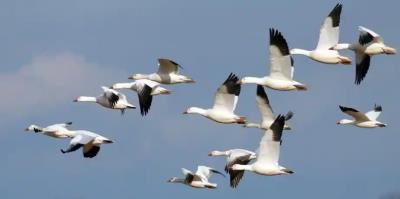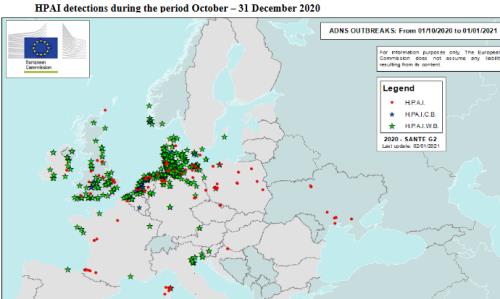 A moderator for ProMed Mail described the sequence of HPAI outbreaks attributed to H5N8 during 2020. Clearly the infection was introduced and disseminated by migratory waterfowl. The implications for the U.S. are self-evident despite the fading recollections of 2015. The description of the sequence of two distinct outbreaks is reproduced below for the benefit of subscribers:-
A moderator for ProMed Mail described the sequence of HPAI outbreaks attributed to H5N8 during 2020. Clearly the infection was introduced and disseminated by migratory waterfowl. The implications for the U.S. are self-evident despite the fading recollections of 2015. The description of the sequence of two distinct outbreaks is reproduced below for the benefit of subscribers:-
"During 2020, 2 distinct epidemic seasons of highly pathogenic avian influenza (HPAI) were observed in the European Union. The 1st HPAI epidemic season started on 31 Dec 2019, with the 1st outbreak in poultry confirmed in Poland. A new HPAI virus of subtype H5N8 (2020) was involved in the outbreak. By March [2020], the disease was confirmed in Poland, Czechia, Germany, Hungary, Slovakia, and Romania.
The H5N8 (2020) subtype of the HPAI virus was responsible for all of these outbreaks. The most affected Member State was Hungary, after the virus entered in the area with a high density of duck and geese holdings. Outbreaks of HPAI were also detected in Bulgaria between March and June 2020, but the virus involved was of subtype H5N8, which also circulated in Bulgaria in 2018-2019. The last outbreak in poultry related to the 1st epidemic season of HPAI was confirmed on 5 Jun 2020”.
" Only 3 wild birds were found infected with HPAI during the 1st half of 2020 (in Germany and Poland). The virus involved was the same as the one detected in the poultry farms”.
Only 3 wild birds were found infected with HPAI during the 1st half of 2020 (in Germany and Poland). The virus involved was the same as the one detected in the poultry farms”.
"The 2nd HPAI epidemic season started at the end of October 2020 when the 1st cases were reported in wild birds in the Netherlands. Again, the 1st HPAI virus detected was of H5N8 subtype, different from the one that circulated in the 1st half of the year [2020]. Since then and until the end of 2020, a high number of dead and sick wild birds, mostly of migratory species, were found to be infected with HPAI viruses of subtypes H5N8, H5N5, H5N1, and H5N3 being detected by several EU countries and the United Kingdom. The largest number of cases in wild birds were reported in the northern part of Germany, in Denmark, and in the Netherlands. Between October and end of December 2020, the disease was also confirmed in poultry in Croatia, Denmark, France, Ireland, Germany, the Netherlands, Poland, Sweden, and the United Kingdom”
Lessons can be derived from the unfortunate experiences with HPAI in the E.U.
- Since wild birds are carriers waterfowl hunting by personnel in the poultry industry should be prevented
- Free-range and backyard flocks are the link between migratory birds and large commercial farms and complexes
- Commercial waterfowl and turkeys appear to become infected in affected regions before chickens
- Solid biosecurity is an effective preventive measure.
- Constant surveillance of wild birds is necessary with appropriate molecular characterization.
- Most governments impose “stamping out” programs to control outbreaks of HPAI. Most Governments in the E.U. effectively eradicate HPAI every year!
- We need effective broad spectrum H5 and H7 vaccines to create immune commercial poultry populations so as to limit mass dissemination as was observed in the 2015 U.S. epornitic and the biphasic E.U. ongoing event.
- Recognition of the OIE principle of regionalization is a tacit recognition of the extent, distribution and periodicity of HPAI.
Comments and contributions are solicited to establish an industry dialog.